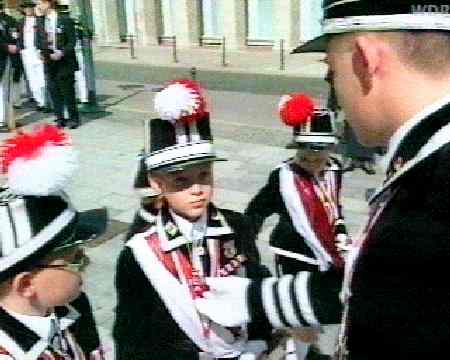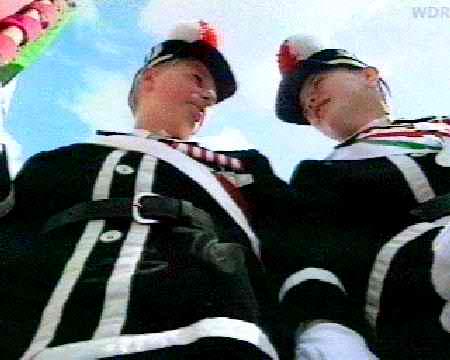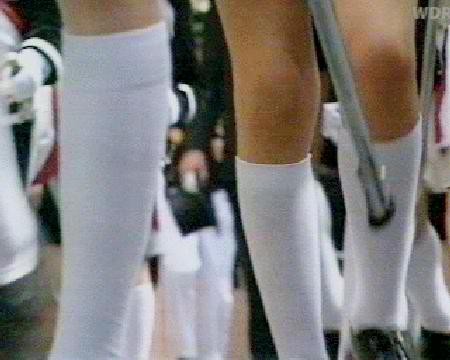
Figure 1.--These German boys wear an elaborate uniform and many boys have a large number of medals. Notice the cross medal, rather like an iron cross, that this boy wears. Click on the image for a view of another boys' medals.

This German group was identified on television as Edelknaben. "Knaben" means "boys". So we know this is a boys' group. The boys are members of a shooting or markmanship club. The group's name translates as "nobel boys". There seem to be a number of these groups in various German cities. The boys here are participating in a parade. I am not sure if it is a civic parade or their own group parade. They appaear to wear a mid-19th century styled unifom rather like the Franco-Prussian War when Germany achieved its independence, but with short pants and white kneesocks which were not worn until much later.
This German group was identified on television as Edelknaben. "Knaben" means "boys". So we know this is a boys' group. I do not know, however, what the rest of the name means or anything about this group. It may not be a group at all, but only boys dressed for a pagent. I notice a lot of other marching groups in the background in military uniforms. I don't, however, see any other boys' groups. These groups are also called Edelknabenkorps. These youth groups belongs to special clubs. We have only limited information a this time. One reader tells us that yjese are junior detachments of shooting or markesmanship clubs. They appear to be all boys clubs. The clubs appear to be have a city name and I think the year founded. There is, for example, the Edelknabenkorps 1951 Kaarst which is the most famous detachment of a shooting (marksmanship) club in Germany. Gun ownership in Germany as in most European countries is much more limited than in America. Even so, shooting is a popular sport despite the very strict regulations on gun ownership.
The edelknaben are a tradition from the western part of Germany. A German reader know of several of these Edelknaben groups. There are, for example, Edelknaben groups in the cities of Kaarst and Neuss.
HBU has never seen a boys' youth group ever wearing a uniform quite like this. It is clearly a uniform for dress wear. The boys would hardly play a wide game dressed like this. They appaear to wear a mid-19th century military-styled unifom, but with short pants and white kneesocks which were not worn until much later. It looks like the Franco-Prussian War (1870-71) period. We are not positive why the uniforms are based on these styles. Perhaps this is when many of the groups were first oganized.

Figure 2.-The boys wear black jackets with elaborate white trim and piping. The caps and jackets look to be based on Franco-Prussian War uniforms. I am not possitive why this is. |
This groups wears a variety of distinctive garments. The black uniform has contrasting white trim. The red and white decoration is repaeted with the cap plume and sashes. We have noted several different Edelknaben in Germany. many have quite similar uniforms, but there are some differences.
The peaked military caps worn by the boys have red and white plumes. The caps are balck with elaborate white trim and polished laeather bill. They looked likr military styles worn about the 1860s-80s. These caps are very distinctive. I have never known a boys' youth group to wear a cap quite like this. They hive the outfit an old fashione military look.
The boys wear black jackets with elaborate white trim and piping. The hackets have collars rather than lapels. The collar like the jacket has white piping. Large white buttons add to the trim.
These boys wear all kinds of medals. As HBC knows nothing about the group, we have no idea how they earned them or what they reprsent. Notice the cross medal, rather like an iron cross, that several boys wear. Some boys seem to be wearing quite elaborate pendants.
The boys wear white shirts under their black jackets, but as the jackets button near the collar, it is difficut to see the shorts.
All of the boys wear black short pants cut at about knee length. Both the newer members and the older boys serving as officers wear short pants. Some of the boys wear plain black shorts. Other boys have shorts with white stripes.

Figure 3.--The black and white caps look rather like a style worn in the 1870s. Presumably Mark is the boys' name and Edelknabenfeldwebel is the name of the group. |
All of the boys wear white tunn-over-top kneesocks. The boys all have their socks pulled smartly up to their knees even though they do not wear garters with their socks. Most of the socks appear to be the turn-over-top socks and not the less expensive type that pull up to the knees without forming a cuff. They are all the light weight kneesocks, not like the heavier type sometimes worn with lederhosen. Other German boys' groups like the Hitler Youth and some Young Pioneer groups, but not the Scouts, have worn white kneesocks. Some German choirs all wore white kneesocks.
Some, but not all of the boys wear black waist belts, but over their jackets which maens that the belt is only ornamental.
Al of theboys wear shoulder sashes. They look like separate red and white sashes. This repeats the red and white cap plumes. Apparently red and whte is the group's color, although I am not sure what it stands for.
All of the boys wear black oxford shoes.
The boys were awarded medals for their markmanship. Here there were competitions within the group and with other clubs. Some boys have uniforms cobered with medals. The boy receicing the most medals was designated king. Most of the medals had red and white sashes as was used for sashes and plumes on the uniform. I'm not sure what the colors signify. There was quite a range of different types of these medals.
The boy in one photograph seems to be holding a sword, although the image is not real clear. Other images show that quite a number of the boys are wearing swords.

Figure 4.--The boy in the middle wears quite a large decoration around his neck. The boy on the left seems to have a sword. Also notice the white stripe on his shorts. |
Germans have a problem in patriotic events. In other countries soliers often take part and military parade units and historical renactors dress up in old uniforms. Germans do not, however, dress up in World War I and World War II uniforms. These uniforms have such sinister conotations around the world and in Germany that they are avoided. Also boys do not wear Hitler Youth uniforms. This group appears to have gone back into the 19th century for less inister uniforms--apparently even the French no longer are too concerned about the Franco-Prussian War. But only the caps really evole that style. The black short pants and white kneesocks are what the Hitler Youth boys wore--and much later in the 1930s.
As the other marching groups also wear military uniforms, the boys appear to be participating in some kind of civic or military parade.
HBU has noted several different terms used with these groups. A HBC contributor reports that "edelknaben" meams "noble boys" and that "edelknabenfeldwebel" means "noble boys sergant". Some boys have uniforms covered with medals. The shooting competitions are held every Spring. The boy who wins is called the Edelknabenkoenig ( this means king ). The Edelknabenkoenig has two assistants. They are choosed by the Edelknabenkoenig himself. Many of these boys are such excellent shots that they have won numerous medals which they proudly wear on their uniforms. They often also receive garlands of flowers.

Figure 5.--All of the boys wear white kneesocks smartly pulled up to their knees. |
There are strict rules about wearing the uniform of the Edelknabenkorps neuss.
A German reader tells us, "With regard to the group pictured here ("Edelknabenfeldwebel") I have found the following, but it was a little difficult. It seems that these fotos were taken in or near the city of Neuss in west Germany near Cologne (Köln). I shall get more informations from my niece who lives in Neuss. The funny word (which I never heard before) consists of edel = nobel; Knabe = boy in elegant language, plural: Knaben, seldom used. No boy today likes to be called a Knabe (because it sounds a lttle like Knospe = bud, soft, as boys often look like, but they don´t want to admit. Edelknabe = a page because in ancient times the pages came from nobel families. Feldwebel = sergeant. I found in www.google.de "Seiten auf Deusch", under "Edelknaben Feldwebel" (words separated) that Edelknaben are the youth group of a certain Schützenverein or rifle club. This rifle club seems to have been founded in the 1980s and maintains an extremely traditional line. The members call themselves Grenadier and wear very traditional uniforms--as you can see in the fotos. A Feldwebel is a sergeant, and thus only one of the boys can be the Feldwebel. But who knows--may be this is a group of sergeants (the word Feldwebel is the same in plural, too) and the whole Edleknaben group is much bigger. All members, it seems, have a certain military rank - but it also seems that they don´t take it very serious, after all that area is the most laughing area in Germany, remember the Kölner Karneval. Under the google section there is more information, may be 10 or pages acme so, but at this moment, I can´t open google."
Navigate the Historic Boys' Uniform Web Site:
[Return to the Maim Unidentified Organizations page]
[Activities]
[Biographies]
[Chronologies]
[Countries]
[Essays]
[Garments]
[Organizations]
[Religion]
[Other]
[Introduction]
[Bibliographies]
[Contributions]
[FAQs]
[Questions]
[Unknown images]
[Boys' Uniform Home]
Navigate the Historic Boys' Uniform Web chronological pages:
[1900s]
[1910s]
[1920s]
[1930s]
[1940s]
[1950s]
[1960s]
[1970s]
[1980s]
[1990s]
